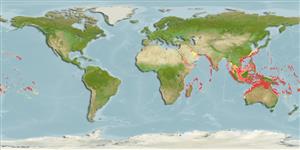>
Eupercaria/misc (Various families in series Eupercaria) >
Lethrinidae (Emperors or scavengers) > Lethrininae
Etymology: Lethrinus: Greek, lethrinia, a fish pertaining to genus Pagellus.
More on author: Klunzinger.
Environment: milieu / climate zone / depth range / distribution range
Ecologia
marino associati a barriera corallina; non migratori; distribuzione batimetrica 0 - 150 m (Ref. 2295). Tropical; 31°N - 28°S, 30°E - 134°W
Indo-Pacific: Red Sea, East Africa and the central Indian Ocean to the Marquesas Islands, north to the Ryukyu Islands.
Size / Peso / Age
Maturity: Lm ? range ? - ? cm
Max length : 70.0 cm FL maschio/sesso non determinato; (Ref. 40637); common length : 59.0 cm SL maschio/sesso non determinato; (Ref. 37816); peso massimo pubblicato: 5.4 kg (Ref. 40637)
Spine dorsali (totale): 10; Raggi dorsali molli (totale): 9; Spine anali 3; Raggi anali molli: 8. This species is distinguished by the following characters: body moderately elongate, its depth 2.8-3.5 times in standard length; head length 1-1.2 times in body depth, 2.6-3 times in SL, dorsal profile near eye convex; snout length about 1.7-2.5 times in HL, measured without the lip the snout is 0.8-0.9 times in cheek height, its dorsal profile nearly straight, snout angle relative to upper jaw between 45° and 60°; interorbital space distinctly concave; posterior nostril a longitudinal or vertical oblong opening, closer to orbit than anterior nostril; eye situated close to dorsal profile, its length 2.8-5.1 times in HL; cheek height 2.3-3.4 times in HL; lateral teeth in jaws conical; outer surface of maxilla smooth; D X, 9 with the third dorsal-fin spine the longest, its length 2-2.8 times in body depth; A III, 8 with the first soft ray usually the longest, its length approximately equal to or shorter than length of base of soft-rayed portion of anal fin and 1.3-1.7 times in length of entire anal-fin base; pectoral-fin rays 13; pelvic-fin membranes between rays closest to body with dense melanophores; cheek without scales; 47-48 lateral-line scales; 4 ½ scale rows between lateral line and base of middle dorsal-fin spines; 15-16 scale rows in transverse series between origin of anal fin and lateral line; usually 15 rows in lower series of scales around caudal peduncle; 5-8 scales in supratemporal patch; inner surface of pectoral fins without scales; posterior angle of operculum fully scaly. Colour of body yellowish grey with scattered irregular dark spots; lips yellowish, upper lip more intense; a red spot at upper base of pectoral fins; fins bluish grey and mottled, bases of fins lighter and edges of dorsal and caudal fins reddish (Ref. 114226).
Occurs in small groups over seagrass beds, sand and rubble areas of coral reefs, deep channels, and lagoons. Usually found in shallow water to depths of 150 m. Usually seen solitary but sometimes swims in small groups. Juveniles in seagrass beds (Ref. 48635). Feeds mainly on crustaceans, fishes, and echinoderms. Caught mostly with handline, traps,
and trawl (Ref. 114226). Minimum depth reported taken from Ref. 128797.
Life cycle and mating behavior
Maturità | Riproduzione | Deposizione | Uova | Fecundity | Larve
Carpenter, K.E. and G.R. Allen, 1989. FAO Species Catalogue. Vol. 9. Emperor fishes and large-eye breams of the world (family Lethrinidae). An annotated and illustrated catalogue of lethrinid species known to date. FAO Fish. Synop. 125(9):118 p. Rome: FAO. (Ref. 2295)
IUCN Red List Status (Ref. 130435)
Threat to humans
Reports of ciguatera poisoning (Ref. 130160)
Human uses
Pesca: commerciale; Pesce da pesca sportiva: si
Informazioni ulteriori
BibliografiaAcquacolturaProfilo di acquacolturaVarietàGeneticaElectrophoresesEreditarietàMalattieElaborazioneNutrientsMass conversion
Strumenti
Special reports
Download XML
Fonti Internet
Estimates based on models
Preferred temperature (Ref.
123201): 24.5 - 29, mean 27.9 °C (based on 1520 cells).
Phylogenetic diversity index (Ref.
82804): PD
50 = 0.5000 [Uniqueness, from 0.5 = low to 2.0 = high].
Bayesian length-weight: a=0.01549 (0.01034 - 0.02321), b=2.96 (2.84 - 3.08), in cm total length, based on LWR estimates for this species & Genus-body shape (Ref.
93245).
Trophic level (Ref.
69278): 3.8 ±0.0 se; based on diet studies.
Resilienza (Ref.
120179): Basso, tempo minimo di raddoppiamento della popolazione 4.5 - 14 anni (K=0.14-0.30).
Prior r = 0.33, 95% CL = 0.22 - 0.49, Based on 2 stock assessments.
Fishing Vulnerability (Ref.
59153): High vulnerability (57 of 100).
Climate Vulnerability (Ref.
125649): Very high vulnerability (76 of 100).
Nutrients (Ref.
124155): Calcium = 30.6 [21.9, 41.4] mg/100g; Iron = 0.718 [0.493, 0.992] mg/100g; Protein = 20.2 [17.5, 22.3] %; Omega3 = 0.133 [0.100, 0.174] g/100g; Selenium = 55.2 [30.8, 81.2] μg/100g; VitaminA = 28.6 [6.3, 148.6] μg/100g; Zinc = 1.88 [1.47, 2.31] mg/100g (wet weight); based on
nutrient studies.
